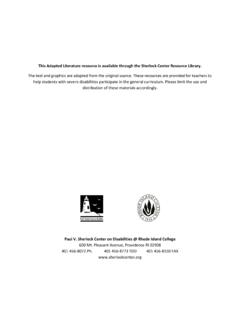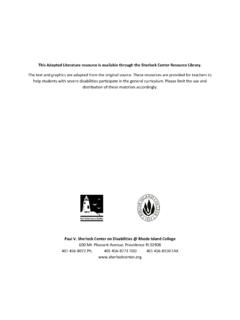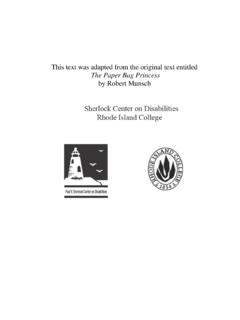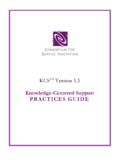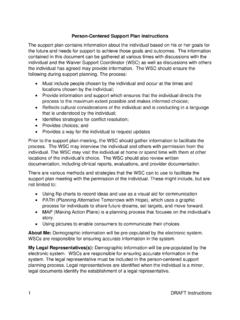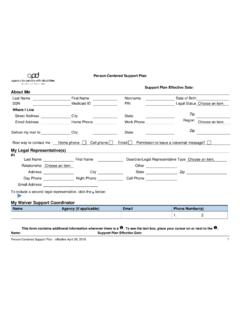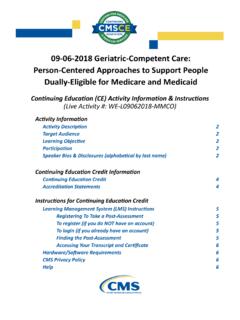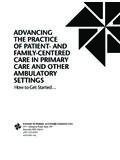Transcription of Rhode Island Person-Centered Thinking Guide - ric.edu
1 Rhode Island Person-Centered Thinking Guide Paul V. Sherlock Center on Disabilities, Rhode Island College Rhode Island Division of Developmental Disabilities May, 2018. Contributors: Tony Antosh Donna Martin Susan Birch Peg McGee Luke Brissette Andrew McQuaide Christine Brunt Carrie Miranda Crystal Cerullo Kevin Nerney Maya Colantuono Kie O'Donnell Mary Beth Cournoyer Mike Purcell Vincent DeJesus Claire Rosenbaum Kelly Donovan Dianne Ross Sue Donovan Kate Sherlock Kim Einloth John Susa Deanne Gagne Eileen Vieira Jackie Gendron Kerry Walker Scott Hopkins Andrew Whalen Deb Kney Jessica Wilcox Karen Flynn Keith Wilcox Karen Keohan Mike Wilson Mary Madden Christine Yankee Alicia Matthews Purpose of this Guide The purpose of the Person-Centered Thinking Guide is to help people, their families and friends, the people who support them, and all community members to implement a meaningful Person-Centered process and to provide Person-Centered services and supports. The Guide is divided into five sections.
2 It begins with an introduction that explains the values and practices that are the foundation for Person-Centered Thinking . There is a diagram that illustrates the steps in the process and a description of the core structural components of a Person-Centered Process and the quality indicators supporting each component. The process of developing a Person-Centered life plan is broken into three phases. There is an implementation checklist that is intended to help the person and facilitator determine that the components and quality indicators have been met. There is a description of each component with a few examples and a few core resources. Additional resources are listed at the end of the Guide . Phase 1 focuses on preparing for the plan. This phase includes selecting a facilitator/advisor;. preparing the person to fully and actively participate in the process; identifying and mapping community opportunities and resources; having a pre-meeting to determine topics to be discussed and topics not to be discussed and selecting a place and time for the meeting; and assembling the person's unique team.
3 Phase 2 focuses on the planning meeting. This phase includes developing a personal profile;. selecting life directions or goals; action planning for each goal; selecting a format for the plan that matches the person's preferences and strengths; and identifying other resources that can support implementation of the plan. Phase 3 focuses on developing the plan. This phase includes developing life directions or goals that are measurable; developing a strategy that allows the person to see his/her own progress;. describing safety considerations; developing a schedule for reviewing the plan; obtaining signatures;. and developing the CMS/BHDDH Plan of Care. 1 Rhode Island Person-Centered Guide Introduction What is Person-Centered Thinking ? Person-Centered Thinking is a set of values, skills, and tools that puts the person at the center of every aspect of life. It is not a plan or a form but is a process through which each person: thinks about the experiences he/she wants to have in life or the goals he/she wants to accomplish.
4 Takes time to discover and learn about those goals Person-Centered Thinking is the and those experiences where they happen, what really happens there, what skills are needed, what basis for Person-Centered supports might be needed, how to get there, and planning. If we don't really other factors; understand the person, plans will be more about the service or develops a plan to reach his/her goals or to have those experiences; support provider than about the person. If the person is not at the acts on that plan (maybe with the help of others); and center of every activity, then most reflects on what he/she has learned or achieved. likely the plan will not be really meaningful to that person. Goals Any service or support is, after all, about the person. or experiences that are set by the person are more likely to be achieved than plans that are developed for the person. Through Person-Centered Thinking each person takes greater control of his/her life. To be more in control each person needs to learn how to participate more fully in the planning process.
5 Each person: needs to have an increasing amount and variety of life experiences so that he/she knows what he/she wants to do;. needs to be fully prepared for any meeting or planning and be able to talk about the questions or topics that come up;. needs to learn how to think about how to achieve that goal or have that experience and needs to be able to communicate the goal or life experience in a way that makes sense for him/her. Through Person-Centered Thinking each person thinks about all of life not just the services or supports that are paid for with public funds. Each person needs a plan for where to live, developing and maintaining relationships with a variety of people, what jobs or careers he/she wants to try, how to have fun, how to stay healthy, how to get around the community, and anything else that is important to each person. Person-Centered Thinking is about being in the world. To be in the world, each person needs to know about the communities in which they live. Through Person-Centered Thinking each person (and their trusted family, friends, and supporters).
6 Learns about the opportunities and supports that are available in their communities. Belonging to community organizations is a very effective way of increasing the person's presence in the community and increasing the kinds of opportunities and experiences available to the person. The most successful plans use a combination of both publicly funded supports and community supports. 2 Rhode Island Person-Centered Guide STEP 1. Person Chooses Facilitator STEP 2 STEP 2. Preparation Community Mapping Person is Prepared to Experiences Set Life Directions Opportunities Plan Action Steps Possible Supports and Discuss Questions Resources STEP 3. Pre-Meeting Topics to Discuss / Not to Discuss Who to Invite When and Where STEP 4 STEP 5 STEP 6. Personal Profile Life Directions or Goals ALL of Life Measurement Strategy Strengths and GIFTS Action Steps Important TO the Community Settings Where it Will Happen Person's Measurement Person Time, Transportation, Supports, Safety Quarterly Review Important FOR the Accommodations and Technology Person Other Resources How to support the Person STEP 7.
7 The Person's Life Plan STEP 8. CMS / BHDDH Plan of Care 3 Rhode Island Person-Centered Guide Although there is no one way to do this, we know that there are components of a Person-Centered process that need to occur for Person-Centered Thinking to change the person's life. The Guide : lists those components, provides a brief explanation of each component, gives examples of a few ways to implement each component, provides some resources, and provides a checklist that helps the person and his/her team implement a true Person- centered Process. The next few pages list all the components of the Person- centered Process and the descriptors that indicate that the process is being implemented with quality. Following that list, Several of the resources in each component is discussed in detail. Some of the this Guide contain links. components have examples and resources. There is a Person-Centered Thinking page on the Paul There are also three checklists to help the person (and his/her facilitator/advisor and other team members) review if they have V.
8 Sherlock Center website completed all the steps. The three checklists are: ( ). Preparation (Components 1-5) where those links are live. This Guide and the other The Planning Meeting (Components 6-9) resources listed in the Guide Plan Writing (Components 8, 10-14) can also be found on that website page. A complete Person-Centered plan would include: Indicators that the person is prepared to actively participate in planning;. Knowledge of community opportunities and experiences that would expand the person's life experiences and match strengths, interests, preferences, and needs;. A personal profile;. Plan details for each area included in the plan (current experiences, statement of goal or life domain expectations, action steps, and implementation details);. Measurement strategies;. Description of strategies and supports to keep the person safe (if needed);. Schedule for review. 4 Rhode Island Person-Centered Guide Person-Centered Process Structural Components Quality Indicators 1. Person has a qualified Person has a choice (more than one) of a qualified facilitator/advisor.
9 Facilitator/advisor of his/her choosing Facilitator/advisor has participated in a training series. Facilitator/advisor understands role and responsibility. Facilitator/advisor has direct experience providing formal or informal support to people. Facilitator/advisor is not connected to an agency that provides direct service to the person. Facilitator/advisor is accountable to the person. 2. Person is prepared to Person is increasing in his/her ability to self-determine , knows actively participate in how to set a direction or goal in life domains of his/her choice and the planning process how to problem solve about steps towards that and goal. Person is learning strategies for participating in the planning. Pre-planning personal preferences and interests. Individual has met with facilitator/advisor (and other trusted ally of individual's choosing) to discuss (a) areas to be included in the discussion/. planning and (b) areas NOT to be included. Person and facilitator/advisor (and trusted allies) should review life domains.
10 (Several tools exist for doing this.). Person and facilitator/advisor (and trusted allies) summarize individual's experience in each of the life domains chosen for discussion. (Note this can serve both as baseline and as documentation of what additional discovery is needed and is led by the individual with supports and prompting as needed). 3. Preparation Based on the life domains identified during pre-planning, the Community Mapping facilitator/advisor has (a) identified resources and opportunities in the community where the person lives (and broader communities), (b) identified individuals or organizations that match the individual's preferences and interests. 5 Rhode Island Person-Centered Guide Person-Centered Process Structural Components Quality Indicators 4. Preparation The person, the facilitator/advisor, and other trusted allies and friends Preliminary Meeting have a preliminary meeting. Decide on topics to be Outline the major topics to be discussed discussed and topics not Identify the topics the person does NOT want to be discussed to be discussed.


